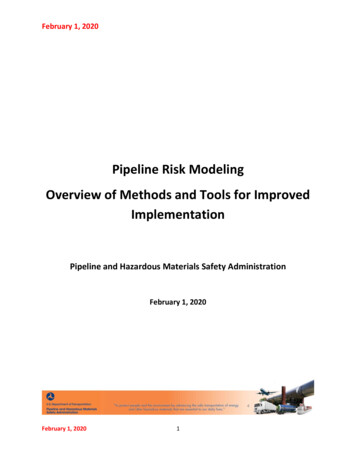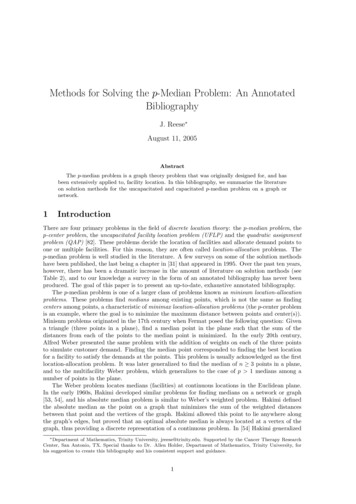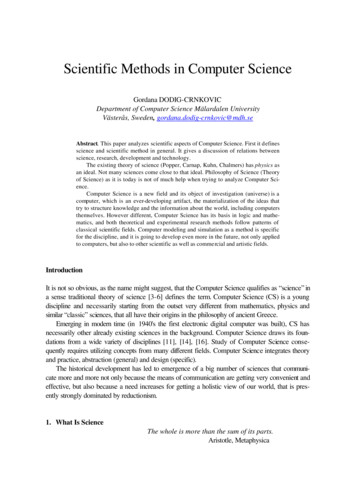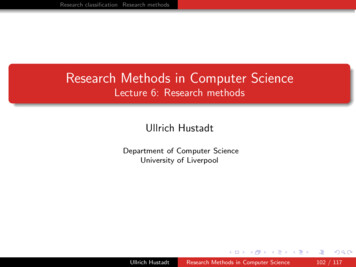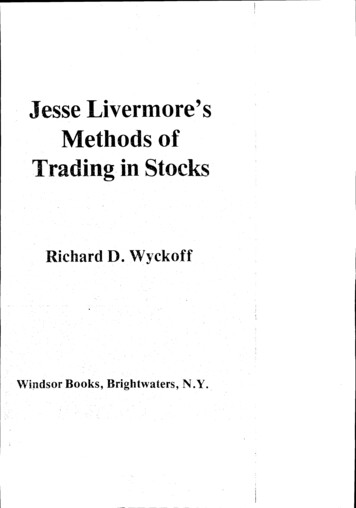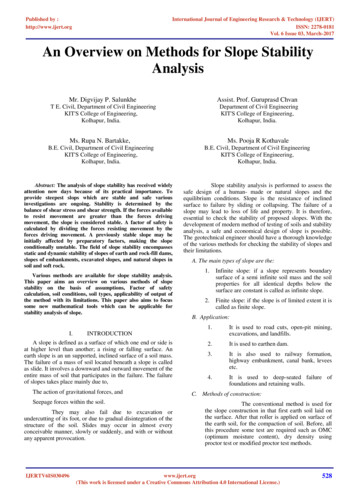
Transcription
Published by :http://www.ijert.orgInternational Journal of Engineering Research & Technology (IJERT)ISSN: 2278-0181Vol. 6 Issue 03, March-2017An Overview on Methods for Slope StabilityAnalysisMr. Digvijay P. SalunkheAssist. Prof. Guruprasd ChvanT E. Civil, Department of Civil EngineeringKIT'S College of Engineering,Kolhapur, India.Department of Civil EngineeringKIT'S College of Engineering,Kolhapur, India.Ms. Rupa N. Bartakke,Ms. Pooja R KothavaleB.E. Civil, Department of Civil EngineeringKIT'S College of Engineering,Kolhapur, India.B.E. Civil, Department of Civil EngineeringKIT'S College of Engineering,Kolhapur, India.Abstract: The analysis of slope stability has received widelyattention now days because of its practical importance. Toprovide steepest slops which are stable and safe variousinvestigations are ongoing. Stability is determined by thebalance of shear stress and shear strength. If the forces availableto resist movement are greater than the forces drivingmovement, the slope is considered stable. A factor of safety iscalculated by dividing the forces resisting movement by theforces driving movement. A previously stable slope may beinitially affected by preparatory factors, making the slopeconditionally unstable. The field of slope stability encompassesstatic and dynamic stability of slopes of earth and rock-fill dams,slopes of embankments, excavated slopes, and natural slopes insoil and soft rock.Various methods are available for slope stability analysis.This paper aims an overview on various methods of slopestability on the basis of assumptions, Factor of safetycalculation, soil conditions, soil types, applicability of output ofthe method with its limitations. This paper also aims to focussome new mathematical tools which can be applicable forstability analysis of slope.I.A. The main types of slope are the:1.Infinite slope: if a slope represents boundarysurface of a semi infinite soil mass and the soilproperties for all identical depths below thesurface are constant is called as infinite slope.2.Finite slope: if the slope is of limited extent it iscalled as finite slope.B. Application:1.It is used to road cuts, open-pit mining,excavations, and landfills.2.It is used to earthen dam.3.It is also used to railway formation,highway embankment, canal bank, leveesetc.4.It is used to deep-seated failure offoundations and retaining walls.INTRODUCTIONA slope is defined as a surface of which one end or side isat higher level than another; a rising or falling surface. Anearth slope is an un supported, inclined surface of a soil mass.The failure of a mass of soil located beneath a slope is calledas slide. It involves a downward and outward movement of theentire mass of soil that participates in the failure. The failureof slopes takes place mainly due to,The action of gravitational forces, andSeepage forces within the soil.They may also fail due to excavation orundercutting of its foot, or due to gradual disintegration of thestructure of the soil. Slides may occur in almost everyconceivable manner, slowly or suddenly, and with or withoutany apparent provocation.IJERTV6IS030496Slope stability analysis is performed to assess thesafe design of a human- made or natural slopes and theequilibrium conditions. Slope is the resistance of inclinedsurface to failure by sliding or collapsing. The failure of aslope may lead to loss of life and property. It is therefore,essential to check the stability of proposed slopes. With thedevelopment of modern method of testing of soils and stabilityanalysis, a safe and economical design of slope is possible.The geotechnical engineer should have a thorough knowledgeof the various methods for checking the stability of slopes andtheir limitations.C. Methods of construction:The conventional method is used forthe slope construction in that first earth soil laid onthe surface. After that roller is applied on surface ofthe earth soil, for the compaction of soil. Before, allthis procedure some test are required such as OMC(optimum moisture content), dry density usingproctor test or modified proctor test methods.www.ijert.org(This work is licensed under a Creative Commons Attribution 4.0 International License.)528
Published by :http://www.ijert.orgInternational Journal of Engineering Research & Technology (IJERT)ISSN: 2278-0181Vol. 6 Issue 03, March-2017D. Methods for analysis:1. Limit equilibrium:a. Analytical technique- Methods of slices Swedish slip circle method of analysis Ordinary method of slices Modified bishop’s method of analysis Lorimar’s method of analysis Spencer’s method of analysis Sarma method of analysis Taylors stability number2. Finite element method: The probabilistic FE method: Perturbation Method Monte Carlo simulation and DirectCoupling Approach.3. Numerical method of modeling: Continuum modeling Discontinuum modeling Hybrid/coupled modelingII.LITERATURE REVIEW1. Carol Matthews and Zeena Farook, Arup; And PeterHelm (2014): Was published “Slope stability analysis–limits equilibrium or the finite element method”.They concluded that, as computers and their applicationevolve in geotechnical analysis; it seems that we shouldbe looking to more advanced ways to analyses slopestability. This study has shown that there are significantopportunities in using the more comprehensive finiteelement analysis. However, the traditional LimitEquilibrium method remains able to produce accurateand reliable results. The both have their advantage sanddisadvantages with the choice of which method to usedepending on some of the considerations describedbelow the method the user selects should be based on thecomplexity of the problem to be modeled. For exampleproblems with complex geometries or that requiresanalysis of seepage, consolidation and other coupledhydrological and mechanical behavior (pore waterpressure induced with more complex mechanical soilresponses (e.g. post failure strain softening andprogressive failure) may be better tackled using FEanalysis.2. Khaled Farah, Mounir Ltifi And Hedi Hassis(2015): were published “A Study of Probabilistic FEMsfor a Slope Reliability Analysis Using the Stress Fields”.In this paper, they were concluded the perturbationmethod and the spectral stochastic finite element method(SSFEM) using random field theory are presented. Thesemethods are applied to analyze the stability of ahomogeneous slope assuming an elastic soil behavior. Toovercome the absence of the analytical solution of themean and standard deviation of the factor of safety, theMonte Carlo simulation combined with the deterministicfinite element code is applied. In fact, the perturbationmethod provides satisfactory results and it is easy toapply even with high random field expansion order.IJERTV6IS0304963. Bozana Bacicn (2014): “Slope stability analysis” inthat paper they conclude a methodology of slope stabilityanalysis and provide an insight into the basic oflandslides and their general terms. Natural process ofconstant affected by change in relationship for shearingstress and resistance.4. A. Burman, S. P. Acharya etc. all (2015):“Comparative study of slope stability analysis usingtraditional limit equilibrium method and finite elementmethod” In that they concluded that present work, limitequilibrium technique (ordinary slice method, Bishop’smethod, Spencer’s method, Morgenstern-Price method)and finite element method have been used to the studydifferent slope stability problems. Also, it is observedthat ordinary slice method provides most conservativeestimation of factor of safety values amongst all the limitequilibrium techniques considered in this paper.Therefore, any design of slopes carried out with ordinaryslice method is likely to be always on the safer side.Other limit equilibrium methods like Ordinary Bishop'sMethod, Spencer's Method and Morgenstern and Price'smethod attempt to establish a more realistic estimation ofinterstice forces which may develop in reality. But theylead to somewhat higher estimation of factor of safety.The FOS values obtained using finite element methodcompare very well with that obtained from limitequilibrium methods. In finite element method, the FOSfor critical slip surface is automatically obtained. In caseof limit equilibrium methods, several slip surfaces shouldbe analyzed to find the critical slip surface. These typesof trial and error calculations are not required with FEMto find out the critical slip surface because the failureoccurs through the zone of weakest material propertiesand automatically the critical slip surface is determined.Furthermore, finite element method satisfies theequations of equilibrium and compatibility equationsfrom theory of elasticity. Therefore, it serves as a moremathematically robust platform. Also, displacements,stress and strains at various nodes in the slope domainare also obtainable from finite element method. Theseare few of the additional benefits of using finite elementmethod.5. Reginald Hammah et, all (1999): “ A comparison offinite element slope stability analysis with conventionallimit equilibrium investigation” - As stated by Griffithsand Lane, , opinions that the FE SSR may be complexoverlook the fact that ‘slip circle’ analyses may producemisleading results. As such we encourage geotechnicalengineers to adopt the SSR as an additional robust andpowerful tool for designing and analyzing slopes. It canhelp uncover important behavior that may otherwise gounnoticed.III. OBJECTIVESTo study principles of limit equilibrium methods andfinite element methods in slope stability analysis.To study the suitability of each method for particularsoil type and slope condition with factor of safety.To suggest mathematical tools for slope stabilityanalysis.www.ijert.org(This work is licensed under a Creative Commons Attribution 4.0 International License.)529
Published by :http://www.ijert.orgIV.International Journal of Engineering Research & Technology (IJERT)ISSN: 2278-0181Vol. 6 Issue 03, March-2017METHODS OF ANALYSISIn slope stability analysis the limit equilibriumand finite equilibrium methods these are two basic types. Themajor difference in between these two methods is following:TABLE I.SCOMPARION OF LIMIT EQUILIBRAM METHOD ANDFINITE ELEMENT METHODLimit equilibrium methodFinite element methodr.no1In limit equilibrium methodcurrently most stability analysisit involves due to mostsimplicity and accuracy.2In limit equilibrium methodit must search for criticalsurface by using geometry.In finite analysis method basedon computer performance hasimproved application of FE ingeotechnical analysis.In finite element method thecritical surface is automaticallyfind out by various software’s.3The advantages of finiteelement method: In FE method isto for model slopes with a degreeof very high realism (complexgeometry, sequence of loading,presenceofmaterialforreinforcement, action of water,and laws of complex soilbehavior)andalsobettervisualizes the deformation of soilin place.It must have complete stressstrain model for soil.The advantages of limitequilibrium method: The limitequilibrium method of slices isbased on purely on theprinciples of statics; that is, thesummation of moments, verticalforces, and horizontal forces.The method says nothing aboutstress, strain and displacements,and as a result it does not satisfydisplacement compatibility.4It’s required only simpleMohr-coulomb soil model.5Itcannotdisplacement.compute6Limit equilibrium methodcannotmodelprogressivefailure.It can compute displacement.Finite element method canmodel progressive failure.[1][2][8]1.Limit equilibrium method:methods may be highly significant to simple block failurealong distinct discontinuities. All these methods are based onthe comparison of forces, moments, or stresses resistingmovement of the mass with those that cancause unstable motion (disturbing forces). The output of theanalysis is a factor of safety, defined as the ratio of the shearstrength (or, alternatively, an equivalent measure of shearresistance or capacity) to the shear stress (or other equivalentmeasure) required for equilibrium. If the value of factor ofsafety is less than 1.0, the slope is unstable.A. GENERAL ASSUMPTION OF LIMIT EQUILIBRIUM:The soil mass must be safe against slope failure on anyconceivable surface across the slope. In this method using thetheory of elasticity or plasticity are also being increasinglyused, the most common method based on limit equilibriumin which it is assumed soil is at verge of failure. The limitequilibrium is statically indeterminate analysis. As the stressstrain relationship along assume surface are not known, sonecessary that system becomes statically determinant and itcan be analyzed easily using the equation of equilibrium.Following assumption are generally made,a) The stress system is assumed to be two-dimensional.The stresses in the third direction (perpendicular tothe section of the soil mass) are taken as zero.b) It is assumed that the column equation for shearstrength is applicable and the strength parameters ϲand φ are known.c) It is further assumed that the seepage conditions andwater level are known, and the corresponding porewater pressure can be estimated.d) The condition of plastic failure as assumed to besatisfied along the critical surface in other wordshearing strains at all points of the critical surfaceare large enough to mobilize all the available shearstrength.e) Depending upon the method of analysis someadditional assumption are made regarding themagnitude and distribution of forces along variousplanes. [1]B. ANALATICAL METHODES OF LIMIT EQUILIBRIUM:Method of slices:Fig. 1. Limit equilibrium methodIn Limit equilibrium methods investigate theequilibrium of a soil mass tending to slide down under theinfluence of gravity. Transitional or rotational movement isconsidered on an assumed or known potential slip surfacebelow the soil or rock mass. In rock slope engineering,IJERTV6IS030496Fig. 2. Method of sliceswww.ijert.org(This work
Slope stability analysis is performed to assess the safe design of a human-made or natural slopes and the equilibrium conditions. Slope is the resistance of inclined surface to failure by sliding or collapsing. The failure of a slope may lead to loss of life and property. It is therefore,Cited by: 5Publish Year: 2017Author: Digvijay P. Salunkhe, Assist. Prof. Guruprasd Chvan, Rupa N. Bartakke, Pooja R Kothavale

